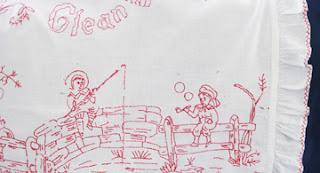Today we are collaborating blogwise on this image.
She's going to analyze the image from her perspective: dog history.See her blog Dr. Barkman Speaks here:
http://doctorbarkman.blogspot.com/2012/10/barry-st-bernard-hospice-mountain.html
And I am going to analyze the technique from my perspective: needlework history.
A redwork pillow sham
1880-1930
Barry is done in what we call redwork, outline embroidery
with Turkey red thread, which was
one of the few colorfast cotton embroidery threads at the time.
Redwork tends to date from 1880 to 1930.
Outline embroidery work in blue tends to date from 1910 to 1930, according to expert Deborah Harding. The fashion for single color embroidery was replaced by one for multicolored embroidery thread about 1920, as manufacturers developed more colorfast shades.
Redwork tends to date from 1880 to 1930.
Outline embroidery work in blue tends to date from 1910 to 1930, according to expert Deborah Harding. The fashion for single color embroidery was replaced by one for multicolored embroidery thread about 1920, as manufacturers developed more colorfast shades.
The graphic style as well as the multicolor
thread date this dog as after 1920.
Less sentimental---more cartoon-like
We can thus date our piece as sometime between
1880 and 1930 by its style.
Outline embroidery done in the
Kensington stitch, also called a stem stitch or outline stitch
The technique of outlining the figure with a simple stitch
became popular as a decorative technique about 1880. Earlier embroiderers
usually filled in their figures, shading with thread, but a new needlework fad
developed after the 1876 Centennial Exhibition in Philadelphia, which strongly
influenced popular taste. American women saw for the first time classic
Japanese design and new ideas in decorative arts inspired by the European Arts
and Crafts movement initiated by William Morris.
Cranes, cat tails and fans were popular images
reflecting the Japanese influence
The Fair introduced technological
innovations such as the Briggs & Co.'s Patent Transfer Papers.
A pillow sham pattern.
Instructions tell you to fill in the flowers with "solid embroidery,"
but no one ever did.
"All
that is required is to lay the Pattern on the Material to be Stamped; pass a
warm iron over the back of the pattern and the design is instantly transferred
to the material." Briggs' hot iron transfer paper and the fresh design
ideas would come together to create an American fad.
Ladies' magazines and thread manufacturers enthusiastically
adopted the new needlework style. By the early 1880s, American embroiderers had
a multitude of published patterns to
copy, usually printed as black and white outlines. Patterns could be
transferred using a variety of the old-fashioned tracing techniques including a
tracing wheel or a form of carbon paper. Patterns could be punched by pricking
holes in the lines and sifting a powder through the holes. Embroiderers could
also buy cotton, linen and silk stamped or printed with an outline or colored
design, essentially kits some call "penny squares." And the new
technology of the heat transfer design with transfer patterns bound into
periodicals and books or offered for sale as single sheets opened up the world
of embroidery to women and children with little training in drawing or art
needlework.
A ruffled pillow sham
Embroiderers also drew their own designs, and our embroidery
may have been hand drawn by its maker who copied a popular image. We assume it
was made to lay atop a pillow because redwork embroidered designs were
extremely fashionable in American bedrooms, particularly as dresser scarves and
pillow shams. Deborah Harding notes that redwork shams were advertised between
1884 and 1890.
A dog with a human face
on a redwork quilt
Late Breaking News
Xenia found this roller-printed chintz printed in 1846 in an
old black-and-white catalog from the Victoria & Albert Museum.
Barry looks more like a sheepdog mix than either a St. Bernard or
a Newfoundland.
References on Outline Embroidery:
Diane Ayers, Timothy Hansen, et al, American Arts and Crafts
Textiles (New York: Abrams, 2002)
Virginia Gunn, "Crazy Quilts and Outline Quilts:
Popular Responses to the Decorative Art/Art Needlework Movement,
1876-1893," Uncoverings 1984 (Mill
Valley, California: American Quilt Study Group, 1985)
Virginia Gunn, "Quilts---Crazy Memories,"
America's Glorious Quilts, editors: Dennis Duke & Deborah Harding (Beaux
Arts Editions: 1987)
Deborah Harding, Red & White: American Redwork Quilts
(New York: Rizzoli, 2000 & 2001)
Penny McMorris, Crazy Quilts (New York: E.P. Dutton,
1984)













The girl with the dog is something that I've run across before. From my understanding it is a Newfoundland. They were quite popular in needlework a century, or more, ago. Perhaps from Peter Pan? Just curious.
ReplyDeleteThank you for the pattern, and all that you do to keep us informed. You are appreciated!
My sister says it's a St. Bernard. Barry to be specific. The breeds have changed so much that it's hard to recognize them now. And isn't that a Peter Pan collar you have on in your photo? I think Peter Pan reflected the Barry craze, but the play probably lengthened the popularity of the breed.
ReplyDeleteYou are so right about the change in some breeds' appearance. Next time you see The Wizard of Oz, look at the pigs in the barnyard; they really look nothing like they do now!
ReplyDeleteThe way I remember that dress, the collar is a bit pointier than a Peter Pan - aren't they more rounded?
Thanks for responding to my comment!
And you are right about the points. I think a true Peter Pan collar has a curved edge.
ReplyDelete